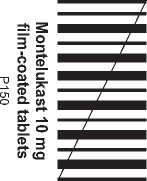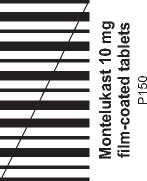Montelukast 10 Mg Film-Coated Tablets
Pharmacode position may change as per Supplier's m/c requirement &additional
small pharma code may appear on the front / back panel
J L


Package leaflet: Information for the user
Montelukast 10 mg film-coated tablets
(Montelukast)
Read all of this leaflet carefully before you start taking this medicine because it contains important information for you.
- Keep this leaflet. You may need to read it again.
- If you have any further questions, ask your doctor or pharmacist.
- This medicine has been prescribed for you only. Do not pass it on to others. It may harm them, even if their signs of illness are the same as yours.
- If you get any side effects, talk to your doctor or pharmacist. This includes any possible side effects not listed in this leaflet. See section 4.
What is in this leaflet:
1. What Montelukast is and what it is used for
2. What you need to know before you take Montelukast
3. How to take Montelukast
4. Possible side effects
5. How to store Montelukast
6. Contents of the pack and other information
1. What Montelukast is and what is it used for
Montelukast is a leukotriene receptor antagonist that blocks substances called leukotrienes.
Leukotrienes cause narrowing and swelling of airways in the lungs and also cause allergy symptoms.
By blocking leukotrienes, Montelukast improves asthma symptoms, helps control asthma and improves seasonal allergy symptoms (also known as hay fever or seasonal allergic rhinitis).
Your doctor has prescribed Montelukast to treat asthma, preventing your asthma symptoms during the day and night.
- Montelukast is used for the treatment of patients who are not adequately controlled on their medication and need additional therapy.
- Montelukast also helps prevent the narrowing of airways triggered by exercise.
- In those asthmatic patients in whom Montelukast is indicated in asthma, Montelukast can also provide symptomatic relief of seasonal allergic rhinitis.
Your doctor will determine how Montelukast should be used depending on the symptoms and severity of your asthma.
What is asthma?
Asthma is a long-term disease.
Asthma includes:
- difficulty breathing because of narrowed airways. This narrowing of airways worsens and improves in response to various conditions.
- sensitive airways that react to many things, such as cigarette smoke, pollen, cold air, or exercise.
- swelling (inflammation) in the lining of the airways.
Symptoms of asthma include: Coughing, wheezing and chest tightness.
What are seasonal allergies?
Seasonal allergies (also known as hay fever or seasonal allergic rhinitis) are an allergic response often caused by airborne pollens from trees, grasses and weeds. The symptoms of seasonal allergies typically may include: stuffy, runny, itchy nose; sneezing; watery, swollen, red, itchy eyes.
- Oral Montelukast is not meant to treat acute asthma attacks.
If an attack occurs, follow the instructions your doctor has given you. Always have your inhaled rescue medicine for asthma attacks with you.
- It is important that you or your child take all asthma medications prescribed by your doctor. Montelukast should not be substituted for other asthma medications your doctor has prescribed for you.
- Any patient on anti-asthma medicines should be aware that if you develop a combination of symptoms such as a flu-like illness, pins and needles or numbness of arms or legs, worsening of pulmonary symptoms, and/or rash, you should consult your doctor.
- You should not take acetyl-salicylic acid (aspirin) or antiinflammatory medicines (also known as non-steroidal antiinflammatory drugs or NSAID’s) if they make your asthma worse.
Use in children
For children 2 to 5 years old, Montelukast Paediatric 4 mg chewable tablets are available.
For children 6 to 14 years old, Montelukast Paediatric 5 mg chewable tablets are available.
Other medicines and Montelukast
Tell your doctor or pharmacist if you are taking, have recently taken or might take any other medicines.
Some medicines may affect how Montelukast works, or Montelukast may affect how other medicines work.
Tell your doctor if you are taking the following medicines before starting Montelukast:
- phenobarbital (used for treatment of epilepsy)
- phenytoin (used for treatment of epilepsy)
- rifampicin (used to treat tuberculosis and some other infections)
- gemfibrozil (used for treatment of high lipid levels in plasma)
Montelukast with food and drink and alcohol
Montelukast may be taken with or without food.
Pregnancy and breast-feeding and fertility
If you are pregnant or breast-feeding, think you may be pregnant or are planning to have a baby, ask your doctor or pharmacist for advice before taking this medicine.
Use in pregnancy
Women who are pregnant or intend to become pregnant should consult their doctor before taking Montelukast. Your doctor will assess whether you can take Montelukast during this time.
Use in breast-feeding
It is not known if Montelukast appears in breast milk. You should consult your doctor before taking Montelukast if you are breastfeeding or intend to breast-feed.
Driving and using machines
Montelukast is not expected to affect your ability to drive a car or operate machinery. However, individual responses to medication may vary. Certain side effects (such as dizziness and drowsiness) that have been reported very rarely with Montelukast may affect some patients ability to drive or operate machinery.
Montelukast 10 mg film-coated tablets contain lactose. If you
have been told by your doctor that you have an intolerance to some sugars, contact your doctor before taking this medicinal product.
2. What you need to know before you take Montelukast
3. How to take Montelukast
Tell your doctor about any medical problems or allergies you have now or have had.
Do not take Montelukast
- if you are allergic to montelukast or any of the other ingredients of this medicine (listed in section 6).
Warnings and precautions
Talk to your doctor or pharmacist before taking Montelukast
- If your asthma or breathing gets worse, tell your doctor immediately.
Always take this medicine exactly as your doctor or pharmacist has told you. Check with your doctor or pharmacist if you are not sure.
- You should take only one tablet of Montelukast once a day as prescribed by your doctor.
- It should be taken even when you have no symptoms or have an acute asthma attack.
- To be taken by mouth
For adults 15 years of age and older:
One 10 mg tablet to be taken daily in the evening. Montelukast may be taken with or without food.
Black
P150
If you are taking Montelukast, be sure that you do not take any other products that contain the same active ingredient, montelukast.
If you take more Montelukast than you should
Contact your doctor immediately for advice.
There were no side effects reported in the majority of overdose reports. The most frequently occurring symptoms reported with overdose in adults and children included abdominal pain, sleepiness, thirst, headache, vomiting, and hyperactivity.
If you forget to take Montelukast
Try to take Montelukast as prescribed. However, if you miss a dose, just resume the usual schedule of one tablet once daily.
Do not take a double dose to make up for a forgotten dose.
If you stop taking Montelukast
Montelukast can treat your asthma only if you continue to take it.
It is important to continue taking Montelukast for as long as your doctor prescribes. It will help control your asthma.
If you have any further questions on the use of this medicine, ask your doctor or pharmacist.
4. Possible side effects
Like all medicines, this medicine can cause side effects, although not everybody gets them.
In clinical studies with montelukast 10 mg film-coated tablets, the most commonly reported side effects (occurring in at least 1 of 100 patients and less than 1 of 10 patients treated) thought to be related to Montelukast were:
- abdominal pain
- headache
These were usually mild and occurred at a greater frequency in patients treated with montelukast than placebo (a pill containing no medication).
The frequency of possible side effects listed below is defined using the following convention:
Very common (affects at least 1 user in 10)
Common (affects 1 to 10 users in 100)
Uncommon (affects 1 to 10 users in 1,000)
Rare (affects 1 to 10 users in 10,000)
Very rare (affects less than 1 user in 10,000)
Additionally, while the medicine has been on the market, the following have been reported:
- upper respiratory infection (Very common)
- increased bleeding tendency (Rare)
- allergic reactions including , swelling of the face, lips, tongue, and/or throat which may cause difficulty in breathing or swallowing (Uncommon)
- behaviour and mood related changes [dream abnormalities, including nightmares, trouble sleeping, sleep walking, irritability, feeling anxious, restlessness, agitation including aggressive behaviour or hostility, depression (Uncommon); disturbance in attention, memory impairment tremor (Rare); hallucinations, disorientation suicidal thoughts and actions (Very rare)]
- dizziness, drowsiness, pins and needles/numbness, seizure (Uncommon)
- palpitations (Rare)
- nosebleed (Uncommon)
- diarrhoea, nausea, vomiting (Common); dry mouth, indigestion (Uncommon)
- hepatitis (inflammation of the liver) (Very rare)
- rash (Common bruising, itching, hives (Uncommon); tender red lumps under the skin most commonly on your shins (erythema nodosum) severe skin reactions (erythema multiforme) that may occur without warning (Very rare),
- joint or muscle pain, muscle cramps (Uncommon)
- fever (Common); weakness tiredness, feeling unwell, swelling (Uncommon)
In asthmatic patients treated with montelukast, very rare cases of a combination of symptoms such as flu-like illness, pins and needles or numbness of arms and legs, worsening of pulmonary symptoms and/or rash (Churg-Strauss syndrome) have been reported.
You must tell your doctor right away if you get one or more of these symptoms.
Ask your doctor or pharmacist for more information about side effects.
Reporting of side effects
If you get any side effects, talk to your doctor or pharmacist. This
includes any possible side effects not listed in this leaflet. You can
also report side effects directly .via
Yellow Card Scheme
Website: www.mhra.gov.uk/yellowcard
By reporting side effects you can help provide more information on the safety of this medicine.
5. How to store Montelukast
Keep this medicine out of the sight and reach of children.
Do not use this medicine after the expiry date, which is stated on the carton/label/bottle after EXP. The expiry date refers to the last date of that month.
Store below 25OC.
Store in the original package in order to protect from light and moisture.
Use within 30 days after first opening the HDPE bottle.
Do not throw away any medicines via wastewater or household waste. Ask your pharmacist how to throw away medicines you no longer use. These measures will help protect the environment.
6. Contents of the pack and other information
What Montelukast contains
- The active substance is montelukast. Each tablet contains montelukast sodium which corresponds to 10 mg of montelukast.
- The other ingredients are:
Tablet Core: Cellulose, microcrystalline (E460), lactose monohydrate, croscarmellose sodium, hydroxypropyl cellulose (E463), magnesium stearate (E572).
Film coating: Hydroxylpropyl cellulose (E463), hypromellose 6cP (E464), titanium dioxide (E171), iron oxide yellow (E172), carnuba wax (E903), iron oxide red (E172).
What Montelukast looks like and contents of the pack
Film-coated tablet
Beige coloured, rounded square shaped, film-coated tablets debossed with ‘X’ on one side and ‘54’ on other side.
Polyamide / Aluminium foil / PVC - Aluminium foil blisters Pack sizes: 7, 10, 14, 20, 28, 30, 49, 50, 56, 60, 84, 90, 98, 100, 140 and 200 tablets
HDPE bottle with polypropylene cap containing silica gel desiccant: Pack sizes: 30 tablets
Not all listed pack sizes will be marketed.
Marketing Authorisation Holder
Milpharm Limited Ares, Odyssey Business Park West End Road South Ruislip HA4 6QD United Kingdom
Manufacturer
APL Swift Services (Malta) Limited HF26, Hal Far Industrial Estate, Hal Far Birzebbugia, BBG 3000 Malta
or
Milpharm Limited Ares, Odyssey Business Park West End Road South Ruislip HA4 6QD United Kingdom